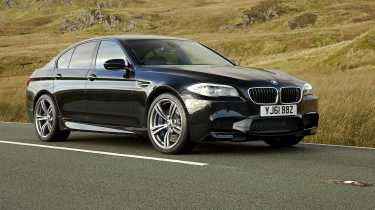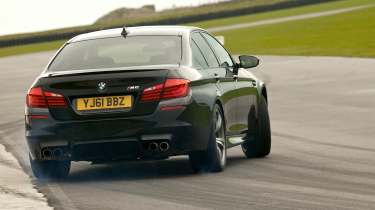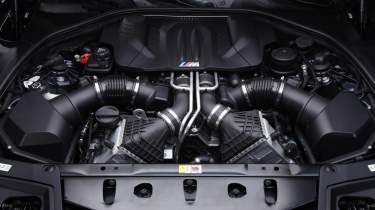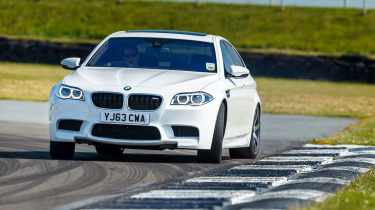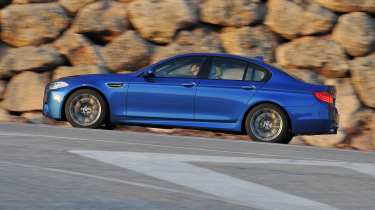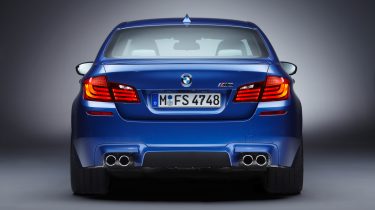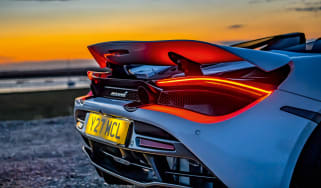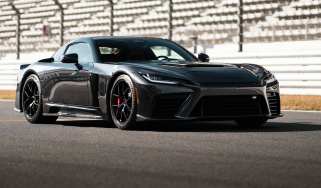BMW M5 (F10, 2011 - 2016) review: a 550bhp super saloon for £20k
Voluminous turbocharged grunt, to match its growth in size and weight, defined the F10 M5
The F10 BMW M5 marked a huge step up in performance, usability and refinement over its predecessor. The wailing motorsport-derived V10 of the E60 was something that could never be equalled, but with superbly judged dynamics, a spectacular turbocharged V8 powertrain and Q-car looks, the F10 was a worthy replacement.
The early 2010s were a transformational period for BMW, but it wasn’t all smooth sailing. The likes of the F80 M3 and F82 M4 were far from perfect in their original forms, but the F10 M5 was different. Launched in 2011 as a rival to Mercedes-AMG’s E63, it got things right from the get-go.
> BMW M5 review – it’s more powerful but is the extra weight a problem?
No other super saloon offered the BMW M5’s combination of mind-bending straight-line performance, dynamic ability and everyday usability. Some mourned the loss of the E60 M5’s manic V10, but the 4.4-litre twin-turbo V8 returned even more performance and used less fuel. The F10 is an altogether more refined machine than the E60, but it still boasts class-leading dynamics and a degree of agility that sits completely at odds with the near two-tonne kerb weight. Whereas the M3 and M4 models of the same generation were less than convincing in their dynamic make-up, the M5 was perfectly judged.
More reviews
The restrained, but handsome exterior styling and superbly appointed cabin simply complete the package. The M5 is much more understated in terms of design than the smaller M3 and M4 models and could, to the untrained eye, be mistaken for any other 5-series. What sets it apart from the mainstream models are the quad tailpipes, small vents in the flanks and deeper front bumper treatment. In a restrained colour the M5 is won’t turn heads, but for many that’s part of the appeal.
Engine, gearbox and 0-62mph time
At its heart was BMW’s 4.4-litre twin-turbocharged S63 V8, and though a reduction in displacement and cylinder count is rarely a good thing, this unit proved to be a perfect match for the M5. Keen, torquey and with 552bhp in its debut tune, the F10 is a fast car even today. It also produces a fantastic high-frequency, flat-plane-crank-like exhaust note in the process (even though the S63 in fact has a cross-plane crank). Thanks in part to its excellent Getrag seven-speed dual-clutch transmission, the 0-62mph sprint takes just 4.3sec, while top speed is limited to 155mph, or 190mph with the optional M Driver’s Package.
Those who made the decision to opt for the Competition Package will see those figures raised by 15bhp, or alternatively, if you can somehow get hold of one of the only 300 ever made, the 30 Jahre edition M5 boasts 592bhp and 516lb ft.
Every version of the M5 uses a seven-speed twin-clutch M DCT transmission. It shifts quickly and clean when left in manual and behaves without any issues whatsoever if the car is left in automatic. The gearbox can be adjusted across a varying range of speed and ferocity, depending on what sort of driving you intend to be doing. The spectrum between soft and smooth and fast and sharp is particularly impressive, as is usually the case with the current generation of BMW M products.
For £6700, buyers could opt for the Competition Package – which adds bigger 20-inch wheels, a sports exhaust and stiffer suspension – and slash 0.2 seconds off that 0-62mph dash. Remarkably, the limited edition 30 Jahre model will dip below four seconds to 62mph. Top speed is limited to 155mph on the standard model, as is the way with many German performance cars, although the 30 Jahre will hit 199mph before its limiter stops play.
Regardless of state of tune that 4.4-litre engine returns effortless torque from the lower reaches of the rev range as well as a potent top end. That means it will pass slower traffic without dropping out of its seventh gear, or return enough straight line performance to trouble serious performance cars should the driver choose to chase the redline in each gear.
Ride and handling
A 1870kg kerb weight is far from featherweight, but over a decade on from the F10’s launch such a figure seems almost acceptable when compared with the 2435kg of the 717bhp, hybridised G90 M5. Compare power-to-weight ratios and this pair are neck-and-neck, the older car 1bhp/ton ahead on 300bhp/ton. The result is a car that feels quick no matter what the scenario, with excellent feedback inspiring confidence on tricky roads, and superb refinement and comfort for those continental crossings.
The M5 is a high performance car, so it does ride with a degree of sharpness. In the Comfort damper mode, though, it’s far from being too stiff for daily use. In fact, it’s refined enough in normal use that the driver soon forgets just how much performance is on offer – the M5 has a rare duality that buyers will grow to love.
It also leads the way for dynamic ability in its class. It has very good body control and flat-bodied response through a sequence of corners, so the driver really can hustle it along a road at speed. Grip levels are huge, with a degree of safety understeer built into the chassis to let the driver know when the car is nudging up against its limits.
The steering is impressively delicate, detailed and crisp for a car of this size, and the locking M differential does a good job of deploying the gargantuan power to the road surface. Naturally, the M5 is well-balanced and agile enough to pull off the most outrageous oversteer slides on the circuit. The adaptive dampers can be turned up to Sport and Sport Plus to sharpen the car’s responses, although the stiffest setting is too much for road use in the UK.
That balance can also be enjoyed on the road without drawing too much unwanted attention because the stability control system has an intermediary M Dynamic Mode. It allows just a little more wheelspin and yaw to let the driver explore the car’s limits without throwing away the safety net altogether.
The standard cast iron brakes are up to the job in fast road driving, but for any track activity the optional M carbon ceramic brakes were worth their £7395 asking price. They also offer the added benefit of improving ride quality slightly thanks to their reduced unsprung weight.
'[On the 30 Jahre M5 special edition:] There’s a real sense of focus about this M5. The 4.4-litre twin-turbocharged V8 has enormous power, of course, but you need the drivetrain set to Sport+ to get the right throttle response, then flick the dampers to Sport (the final setting is too stiff for the road), the steering to Sport, and turn up the M DCT gearbox for maximum shift speed. It’s a really good ’box this: so much crisper than an auto and the short paddle action matches the machined thud of each upshift beautifully. The optional ceramic brakes feel sensational, while the steering response is quick but intuitive. All the ingredients start to come together very quickly. With confidence high you can start to use that front-end response, then load up the M differential on corner exit and punch in those delicious upshifts.
Intensity. I think that’s the word that best describes the M5’s blend of fury, accuracy and balls-out excitement. It isn’t perfect – the engine does display a little turbo lag on corner exit, which can be frustrating, and as with the E63 the rear axle occasionally feels like it’s being tied in knots by the torque. But boy is it addictive. It feels big but nimble, scarily fast but in a life-affirming sort of way, and when all is said and done, it’ll get down and dirty like M5s always have. Maybe BMW knows how to celebrate a big birthday in style after all. Still invincible, still a step ahead of its rivals; the 30 Jahre M5 is the super-saloon of choice.' Jethro Bovingdon, evo 208
What we said
‘You know the way a really good auto ’box instinctively knows when to hold a gear and when to drop a cog? That’s what this DCT does. The calibration is exemplary. Somehow it manages everything with serene indifference. Compared with the V10 M5’s auto mode, it’s a revelation.
‘As for the driveability, character and flexibility of the radical new motor, well, they’re all exceptional. Does it rev like the old V10? Of course it doesn’t. But just as the torque curve subsides, so the power takes over and the result must be one of the most remarkable powertrains of modern times.
‘The car feels noticeably heavier than its predecessor, but the brakes are just fine. They make plenty of noise but the pedal stays firm and the stopping power is commensurate with something that weighs so much and yet builds speed so quickly.
‘Like the best M-cars, it doesn’t feel like a fast 5-series, it feels like a stand-alone model. Something too heavy and not perfect, but still something very special indeed.’ – road test, December 2011, evo issue 163
BMW M5 (F10) buying guide
Buying a car like an F10 M5 is always a tricky task, with many having been abused, badly modified and crashed in their early years, and neglected as values have fallen. Eliminating category write-off cars from your search is a good start, but beware cars with aftermarket parts, questionable ‘upgrades’ and a high number of previous owners.
What to look out for
The F10 is a relatively reliable car, but pay special attention to frequency of oil changes and where work has been carried out. The likes of rear springs, fuel pressure sensors, fuel pumps, coil packs, injectors and differentials have all been known to require attention, but significant failures are not common. There have been a number of recalls throughout the F10’s lifetime, so ensure these have been addressed.
Servicing intervals are variable, depending on usage. The S63 uses timing chains, so there are no belts to replace, but the third service is the biggie, as it includes transmission fluid, spark plugs and other pricey items.
The F10 M5 had big brakes and big tyres to harness its big power. As such, these consumables can be expensive to replace – hundreds per corner for new meats and over £1300 for a full set of genuine brakes. Ceramics? Don't ask. Tyres seem to last surprisingly well, with some owners even reporting getting 20,000- plus miles from the rears. The F10 was a heavier M5 too and so has heavy-duty suspension components. It will also ride its rubber bushings harder, so be sure that they're all in good condition.
Running a twin-turbo 4.4-litre V8 is never going to be cheap, but BMW claims a reasonable 28.5mpg on the combined cycle. On a motorway run that could just creep into the 30s, but the moment you stretch the car over an inviting stretch of road it could equally drop into the low teens.
What to pay
The F10 M5 represents one of the best value-for-money cars of its kind in 2025, with 100,000-mile examples available for just under £15,000. If you’re not feeling quite so brave, a car with around 45,000 miles can be had for as little as £25,000, while a 20,000-mile Competition-spec model (567bhp) should cost under £35,000. The most desirable and expensive of the bunch is the 592bhp 30 Jahre Edition, but given it was limited to just 30 units you may have to wait a while for one to appear in the classifieds. Expect to pay just over £50,000 for a 10,000-mile example, or as little as £30,000 for a 50,000-mile car. But whichever F10 you choose, it’s a lot of supersaloon for the money.
BMW M5 (F10) specs
| Engine | V8, 4395cc, twin-turbo |
|---|---|
| Max power | 552bhp @ 6000-7000rpm |
| Max torque | 501lb ft @ 1500-5750rpm |
| Transmission | Seven-speed DCT, rear-wheel drive, Active M Differential |
| Weight | 1870kg |
| Power-to-weight | 300bhp/ton |
| 0-62mph | 4.4sec (claimed) |
| Top speed | 155mph (limited, 190mph option) |
| Price new | £73,040 (2011) |
